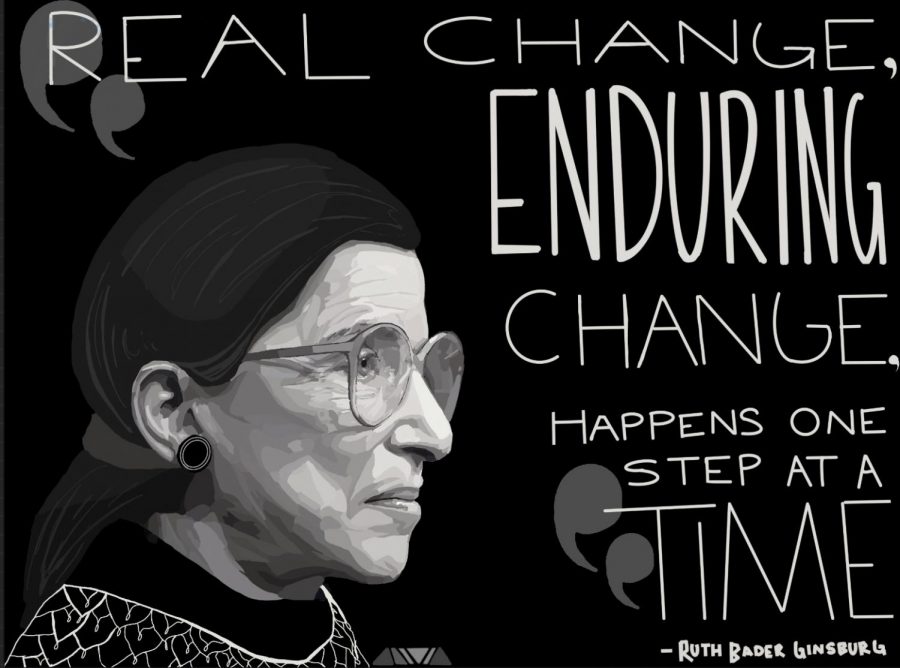Ruth Bader Ginsburg’s life and legacy
In memory of Ruth Bader Ginsburg; a fallen hero to many.
October 15, 2020
On Sept. 18, 2020, Supreme Court Justice Ruth Bader Ginsburg, aged 87, passed away. The actions completed throughout the course of her life have left behind a colossal impact on the United States of America. The laws and precedences she has set will reverberate through human history for years to come, especially among the younger generations. Many of the freedoms associated with civil rights that we are afforded today as a result of Ginsburg’s work.
The early days of Ruth Bader
Joan Ruth Bader grew up during World War II in multicultural Brooklyn. Her happy childhood was shadowed by the dark realities across the Atlantic.
Ruth Bader Ginsburg attended Cornell in 1950, shortly after her mother’s death. At Cornell, where she majored in Government, Ginsburg met her husband, the beloved Marty Ginsburg. They married in 1954, shortly after she graduated from Cornell. About a year later, their first child, Jane Ginsburg, was born.
Ginsburg explained in a 2015 interview with NBC what made her husband so special, “Marty was an extraordinary person. Of all the boys I had dated, he was the only one who really cared that I had a brain. And he was always, well, making me feel that I was better than I thought I was.”
The young couple went to Harvard Law in 1956 where they juggled coursework and caring for their young daughter, Jane. During Marty’s third year at Harvard, he was diagnosed with cancer. While undergoing treatment, Ginsburg took on his coursework, in addition to her own at Harvard, to help him graduate. She later transferred to Columbia, where she graduated at the top of her class, for her last year of Law school.
In 2014, Ginsburg recalled in an interview with Katie Couric what made her partnership so successful; “If you have a caring life partner, you help the other person when that person needs it. I had a life partner who thought my work was as important as his, and I think that made all the difference for me.”
A storm brewing
Ginsburg didn’t initially set out to work in civil rights. When she decided to go to law school it was because she believed a lawyer was the only job she’d be any good at, the sexist realities of working in male-dominated fields in the 1950s quickly changed her goals.
During the summer of her second year of law school, Ginsburg worked at a top law firm in New York in which she did excellent work, causing her to expect a job offer upon graduation—future Justice Ginsburg never received a job offer. The twelve other firms she interviewed at responded similarly. She also was recommended for a clerkship with Supreme Court Justice Felix Frankfurter who declined because he didn’t want to hire a woman.
In the workforce of the 1950s, she had a difficult hand, “I was Jewish, a woman and a mother. The first raised one eyebrow; the second, two; the third made me indubitably inadmissible.”
Ginsburg’s early experience with discrimination in the workforce influenced her passions later in life. Many of her efforts became centered around mothers in the workforce, she believed it should be fully permissible for women to have a job and a family without being discriminated against in the workplace.
A titan of gender equality

In 1963 Ruth Bader Ginsburg got a job at Rutgers University. Her time at Rutgers inspired her to pursue gender equality. Ruth’s second child, James Ginsburg, was born in 1965 during her time teaching at Rutgers.
From 1972 to 1980, Ginsburg worked as a law professor at Columbia University and eventually became the first female professor to receive tenure at Columbia.
While she was a professor at Rutgers, Ginsburg co-founded the Women’s Rights branch of the American Civil Liberties Union as Executive Director of the Women’s Rights Project in 1972. The Women’s Rights Project was the successor of Pauli Murray and Dorothy Kenyon’s work at the ACLU.
Ruth’s passion for equality didn’t stop at women’s issues; she was also an adamant advocate for men’s issues, proving once again her dedication as a woman who fought for equality between the sexes. The majority of cases she argued before the Supreme Court were on behalf of men who had been discriminated against.
Appointed and confirmed
In 1993, Bill Clinton appointed Ruth Bader Ginsburg, making her the first Jewish woman to serve on the Supreme Court.
During her 27 years on the bench Ruth Bader Ginsburg penned both key dissents and majorities. A dissent is a writing disagreeing with the majority opinion of the court. For example, in 1999, Ginsburg’s majority decision on Olmstead v. L.C. helped prevent the abusive/unnecessary institutionalization of people with mental disabilities. The case started after two women suffering from mental illness completed their treatment at a Georgia state-run hospital but were unlawfully kept in the psychiatric unit for multiple years after doctors had already deemed them ready to leave. They had to file suit under the Americans with Disabilities Act to be released from the hospital, which went all the way to the high court.
Another example was when Ginsburg dissented on one of the biggest Supreme Court Decisions in the last 20 years: Bush v. Gore. She opposed the vote to not count disputed ballots in Florida, securing the election for George W. Bush.
Abortion rights came into question in 2007 during the case Gonzales v. Carhart. Justice Ginsburg chose to read her dissent from the bench arguing that unholding a federal ban on partial-birth abortions was retreating from Roe v. Wade, successfully protecting reproductive rights in America.
In 2013, Ginsburg became the first Justice to officiate a same-sex wedding. She married her friend Michael Kaiser and his fiance John Roberts at the Kennedy Center just three months after the landmark Supreme Court decision United States v. Windsor.
Going out with a fight
In recent years, the liberal Justice was hell-bent on outliving the Trump Administration despite the many occasions in which she could’ve retired.
In November 2018, Ginsburg broke three ribs after a fall in her office. A few weeks later she returned to the hospital with lung problems. She was back in the Supreme Court and working out at the gym within weeks.
In August 2019, Ginsburg spent three weeks in chemotherapy for pancreatic cancer. Aside from canceling a trip to Santa Fe, her schedule didn’t slow at all.
When she was hospitalized in May of 2020, she continued to present her arguments from the hospital. Ginsburg never let anything slow her pursuit of justice or halt her unstoppable work ethic.
Ginsburg was the epitome of tiny, resilient, Ashkenazi women who refused to die. She seemed like she’d be around forever, holding reproductive rights and a progressive majority Supreme Court on her little shoulders. In a way, it’s fitting she spent her last days as she spent her whole life; fighting for what she believed in. The Notorious Ruth Bader Ginsburg, indisputably, went down in history.
















Ron Ander • Oct 27, 2020 at 3:42 pm
The future is in good hands with young writers like Lila who hopefully will grow up to become a leader that will guide us with her intelligance and high moral standing. Society is in a mess and good leadership is the solution. Great article. Ron Ander – Toronto
Kat • Oct 26, 2020 at 12:56 pm
Excellent article. You will do your generation right, Lila.
Lead the way, and, lead in the way that RBG did.